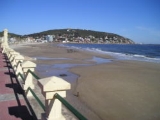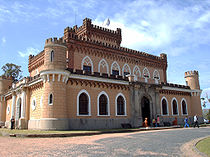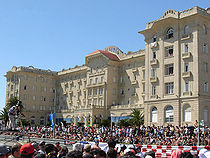
Piriápolis
Encyclopedia
Piriápolis is a city in the Maldonado Department
of Uruguay
. It is located on the coast of Río de la Plata
, on Route 10
and its intersection with Route 37. It is about 105 kilometres (65.2 mi) east of the national capital, Montevideo
(via Ruta Interbalnearia
and Route 37). Piriápolis is an important summer resort in the country, predating the larger and more popular resort town of Punta del Este
. Because it is mainly used as a resort, it has a relatively small permanent population for a city of its size.
, Cerro del Inglés and Cerro del Toro, all the way south to the beach. In 1897 he finished the construction of his personal residence, the Castle of Piria, in 1905 the construction of "Hotel Piriápolis", today known as "Colonia Escolar de Vacaciones", in 1910 he constructed the coastal avenue Rambla de los Argentinos, and in 1912 he started selling the first building lots. In 1913 he established a scenic steam train line joining the (under construction) Port of Piriápolis with the Cerro Pan de Azúcar. The construction of the port finished in 1916. From 1920 to 1930 he constructed the Argentino Hotel, one of the biggest hotels of South America of the times. When Piria died, his natural and legal children started fighting each other over the inheritance.
Source: Instituto Nacional de Estadística de Uruguay

 The city is centered around the Rambla de los Argentinos, a waterfront promenade. With a tourism-centered economy, Piriápolis has opulent hotels, large casinos
The city is centered around the Rambla de los Argentinos, a waterfront promenade. With a tourism-centered economy, Piriápolis has opulent hotels, large casinos
, an active nightlife
scene, and public parks. The Templo de San Antonio, situated atop one of the hills surrounding the city, can be reached by chair lift and offers a panoramic view of the coast. For more adventurous travelers, Uruguay's third-highest point, the Cerro Pan de Azúcar
, can be found 10 km outside of town. The peak presents a challenging climb as well as a nature reserve. Boat tours and saltwater fishing are available at the Piriápolis port.
The Castle of Piria, near Piriápolis, is open to the public. The poet Julio Herrera y Reissig
resided at the Castle for a period.
Maldonado Department
The Maldonado Department , with an area of and 140,192 inhabitants, is located to the southeast of Uruguay. Its capital is Maldonado.-Geography and climate:...
of Uruguay
Uruguay
Uruguay ,officially the Oriental Republic of Uruguay,sometimes the Eastern Republic of Uruguay; ) is a country in the southeastern part of South America. It is home to some 3.5 million people, of whom 1.8 million live in the capital Montevideo and its metropolitan area...
. It is located on the coast of Río de la Plata
Río de la Plata
The Río de la Plata —sometimes rendered River Plate in British English and the Commonwealth, and occasionally rendered [La] Plata River in other English-speaking countries—is the river and estuary formed by the confluence of the Uruguay River and the Paraná River on the border between Argentina and...
, on Route 10
Route 10 (Uruguay)
Route 10 is a national route of Uruguay. In 1983, it was assigned the name Juan Díaz de Solís, after a national hero of Uruguay.The distance notation along Route 10 uses the same Kilometre Zero reference as Routes 1, 3, 5, 6, 7, 8, 9 and IB, which is the Pillar of Peace of Plaza de Cagancha in the...
and its intersection with Route 37. It is about 105 kilometres (65.2 mi) east of the national capital, Montevideo
Montevideo
Montevideo is the largest city, the capital, and the chief port of Uruguay. The settlement was established in 1726 by Bruno Mauricio de Zabala, as a strategic move amidst a Spanish-Portuguese dispute over the platine region, and as a counter to the Portuguese colony at Colonia del Sacramento...
(via Ruta Interbalnearia
Ruta Interbalnearia
Ruta Interbalnearia or Ruta Líber Seregni is a national route of Uruguay. It connects Montevideo with Punta del Este to the east along the coast. The road is approximately in length...
and Route 37). Piriápolis is an important summer resort in the country, predating the larger and more popular resort town of Punta del Este
Punta del Este
Punta del Este is a resort town on the Atlantic Coast in the Maldonado Department of southeastern Uruguay. It is located on the intersection of Route 10 with Route 39, directly southeast of the department capital Maldonado and about east of Montevideo...
. Because it is mainly used as a resort, it has a relatively small permanent population for a city of its size.
History
Piriápolis was founded in 1893 by Francisco Piria. Its initial name was El Balneario del Porvenir (the Resort of the Future). In 1890, Piria had bought a very big stretch of land, including the hills Cerro Pan de AzúcarCerro Pan de Azúcar
Cerro Pan de Azúcar is a hill and the third highest point of Uruguay, with an altitude of 423 metres .-Location and features:...
, Cerro del Inglés and Cerro del Toro, all the way south to the beach. In 1897 he finished the construction of his personal residence, the Castle of Piria, in 1905 the construction of "Hotel Piriápolis", today known as "Colonia Escolar de Vacaciones", in 1910 he constructed the coastal avenue Rambla de los Argentinos, and in 1912 he started selling the first building lots. In 1913 he established a scenic steam train line joining the (under construction) Port of Piriápolis with the Cerro Pan de Azúcar. The construction of the port finished in 1916. From 1920 to 1930 he constructed the Argentino Hotel, one of the biggest hotels of South America of the times. When Piria died, his natural and legal children started fighting each other over the inheritance.
Population
In 2004, it had a population of 7,899 permanent inhabitants and 7,123 dwellings.| Year | Population | Dwellings |
|---|---|---|
| 1963 | 4,549 | 2,620 |
| 1975 | 5,240 | 3,661 |
| 1985 | 5,878 | 4,289 |
| 1996 | 7,570 | 5,640 |
| 2004 | 7,899 | 7,123 |
Source: Instituto Nacional de Estadística de Uruguay
Places of interest


Casino
In modern English, a casino is a facility which houses and accommodates certain types of gambling activities. Casinos are most commonly built near or combined with hotels, restaurants, retail shopping, cruise ships or other tourist attractions...
, an active nightlife
Nightlife
Nightlife is the collective term for any entertainment that is available and more popular from the late evening into the early hours of the morning...
scene, and public parks. The Templo de San Antonio, situated atop one of the hills surrounding the city, can be reached by chair lift and offers a panoramic view of the coast. For more adventurous travelers, Uruguay's third-highest point, the Cerro Pan de Azúcar
Cerro Pan de Azúcar
Cerro Pan de Azúcar is a hill and the third highest point of Uruguay, with an altitude of 423 metres .-Location and features:...
, can be found 10 km outside of town. The peak presents a challenging climb as well as a nature reserve. Boat tours and saltwater fishing are available at the Piriápolis port.
The Castle of Piria, near Piriápolis, is open to the public. The poet Julio Herrera y Reissig
Julio Herrera y Reissig
Julio Herrera y Reissig, was a Uruguayan poet, playwright and essayist, who began his career during the late Romanticist period and later became an early proponent of Modernism.-Background:...
resided at the Castle for a period.

